Dive Brief:
- Despite global currency exchange headwinds due to the strong U.S. dollar and a slower-than-expected roll out of domestic infrastructure funds, Dallas-based contractor AECOM posted increased profit in the third quarter. The firm reported earnings of $105.6 million, or $0.75 per share, up 9.8% from a year ago, on revenue of $3.43 billion, an uptick of 2.2% from the same period in 2021.
- For its full fiscal year 2022, which ended Sept. 30, the firm had profits of $310.6 million on $13.15 billion in revenue. On an adjusted basis, which excludes one-time charges and fees, the company had earnings of $0.89 per share in its fiscal fourth quarter, and beat analysts’ consensus estimate of $0.83, but fell short of hitting revenue targets by about $130 million, according to stock analysis site SeekingAlpha.
- The firm’s total backlog increased to $40.18 billion, up 4% from a year ago. AECOM issued guidance for fiscal 2023 of $3.55 to $3.75 per share on an adjusted basis, in line with analysts’ expectations of $3.71, according to SeekingAlpha, and affirmed its long-term fiscal 2024 target of $4.75 per share.
Dive Insight:
Troy Rudd, AECOM’s CEO, reiterated on a call with analysts that if it hadn’t been for foreign currency exchange challenges and slow funding for the Infrastructure Investment and Jobs Act — which became law one year ago Tuesday — the firm would have performed even better. But that delayed timeline is also what gave him confidence in the firm’s outlook going forward.
“This funding is committed, and we expect these short-term impacts to resolve and create strong, multiyear tailwinds,” Rudd said. “If something doesn't come to market as fast as you had thought, that means that it's probably going to stay there for longer than you had thought.”
That’s not to say that no infrastructure funds have reached the market. Earlier this month, the White House detailed $185 billion that’s been deployed thus far.
But Rudd said it matters how those funds are distributed. For example, while transportation-related budgets often need to flow through states or other agencies, he said funds used for water infrastructure were often more direct, a fact that has helped AECOM’s water business.
Rudd also commented that AECOM is benefiting from the broader trend of onshoring of U.S. firms’ manufacturing facilities, both directly and indirectly.
“We certainly have a lot of exposure to clients as they relocate and build new infrastructure to support supply chain changes,” Rudd said. “Then there’s the supporting infrastructure. For example, a lot of these changes in facilities that are being built use a lot of water, and our water business is participating in that.”
He said that in the burgeoning semiconductor manufacturing space, AECOM is also seeing activity via its program management business, which helps clients move through the building permitting process.
Not all positive
On the other hand, in addition to currency and funding challenges, Rudd said some clients had been spooked by larger concerns about the economy and rising interest rates.
“We certainly have seen in the quarter a couple of nontraditional development investors — not large, mainstream developers — who decided to not proceed with projects,” Rudd said.
Among projects AECOM highlighted for the quarter were:
- Aiding in the rebuilding of the Sanibel Island Causeway in Florida after Hurricane Ian.
- A nine-figure program management contract for the California High Speed Rail project.
- A program management contract from San Diego Gas & Electric to move a substantial share of its grid infrastructure underground to protect against wildfire.
- The Padre Dam East County Advance Purification project in California to address growing drought concerns.













